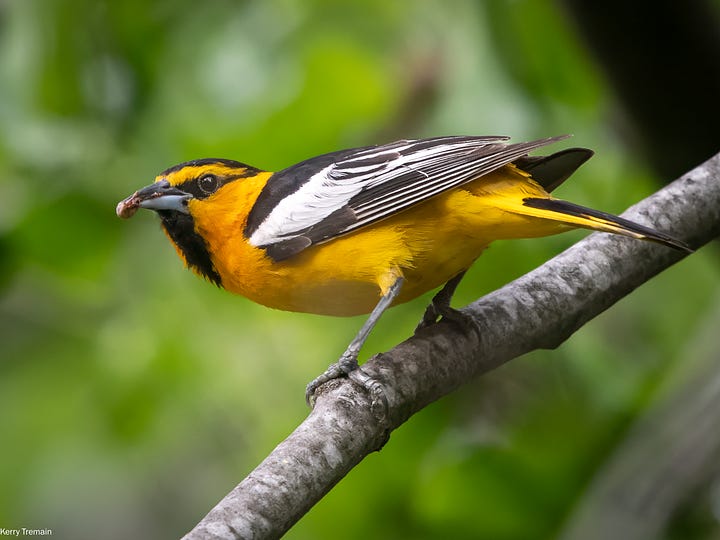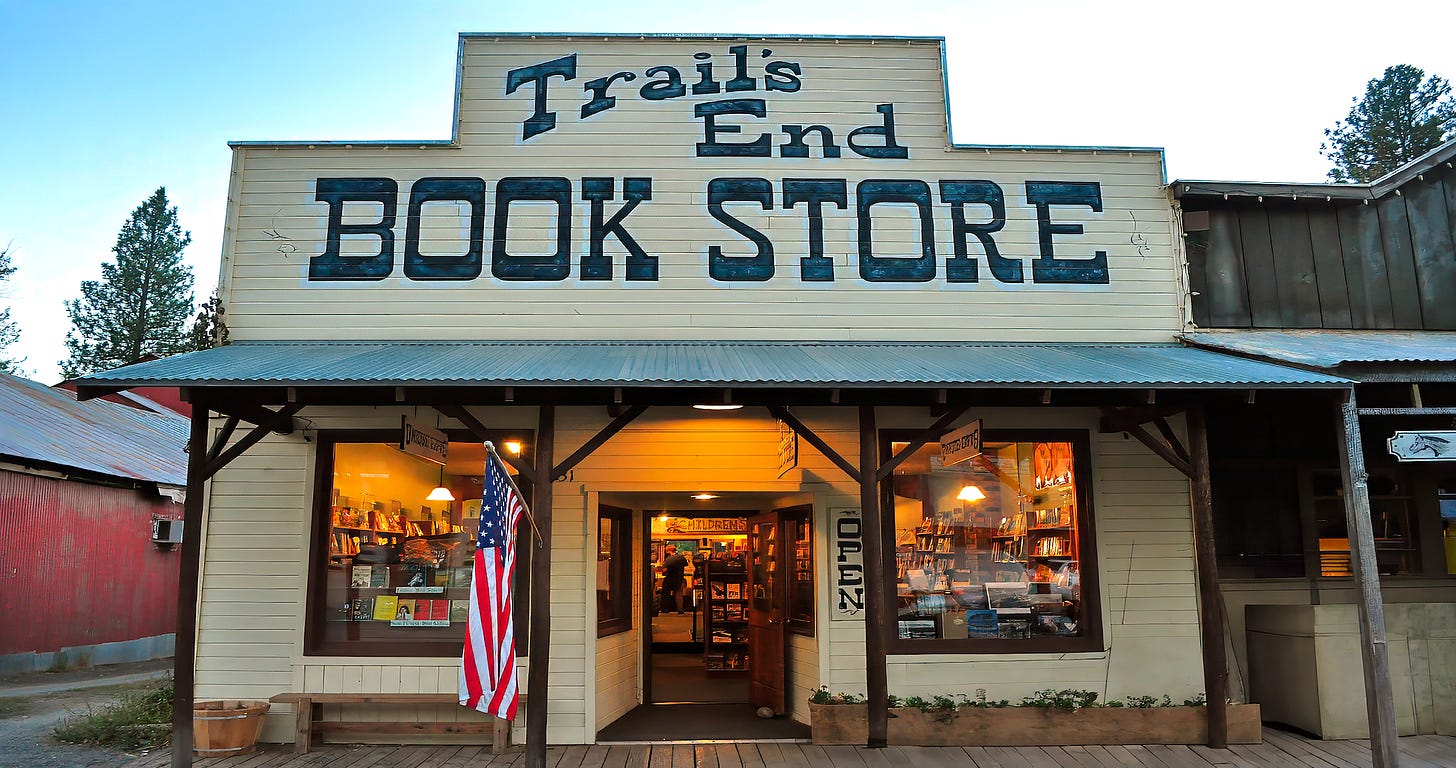2024 reads—five faves
Plus a cherished bird walk memory, a power rainbow, and a stardust poem for the holidays.
BIRD NOTE NO. 29


One to remember
KRIS HOPPE COLORED everything around her. Over her life, she mastered weaving, quilting, painting, and sculpting with glass, and color was her true north in every medium. When I met Kris, she was seventy-eight years old and living with her husband Wolfe in Ashland, Oregon. Their hillside home was filled with her creations. She had glass and quilting studios in the backyard and had recently invented a way to make mobiles from disks of cut paper stiffened with colored paste. I liked Kris immediately—her wide-eyed yet practiced curiosity, her generous warmth, her bemused smile. And in the summer of 2018, two years before she died, we took a bird walk together that will stay with me for the rest of my life.
Ashland is surrounded by the Siskiyou Mountains, and the valley’s many creeks attract a plentiful mix of water and forest birds. The day after arriving at the Hoppe home that summer, I got up early and hunted for birds at a nearby lake and along one of the main creeks in town. When I returned around ten, scrambled eggs, toast, and fruit were laid out on a table on the deck. At breakfast, I described the birds I’d encountered—a bluebird family, an osprey diving for fish, and the acorn woodpeckers that eluded my camera. Kris listened quietly and, after a pause, surprised me by asking if she could go with me the next day. I said I’d be happy to take her, but we’d have to leave before sunrise to catch the early light.
At five the next morning, I found her waiting in the driveway. A nervous Wolfe was also there. He urged her not to go and reminded me that she’d had a recent fall. She gave him a warm smile and then climbed in the car. “I guess it’s nice to have someone who cares about your wellbeing,” she said as we drove away. Kris did need my arm a couple of times as we made our way down a creek-side trail, but walking slowly and deliberately is an advantage when trying not to startle birds. About an hour in, we came to a bridge across the creek, a sturdy affair with metal guardrails. To one side, a yard-wide strip of grass ended in a steep drop to the creek below. Kris went straight for the grass strip and, alarmed, I went straight after her. When I got close, she abruptly sat down on the grass and pointed to a woven nest hanging on a branch ten feet away. For the next hour, we sat quietly, holding hands, and watched flame-orange Bullock’s Orioles repeatedly fly off and then return with insects to feed their young.
Editor’s note: An earlier version of this story was published in my 2023 newsletter, Bird of the Week, the predecessor to Wild Things. The original twenty-nine essays from Bird of the Week are available on my web site. –KT
PICTURE & WORDS
O arco-íris
A LONG TRAIN RIDE from Porto landed us in Pinhao, a small river port in the wine-making region of Douro Valley. It was raining when Barbara and I checked into our second-floor room of a small hotel facing the train station. When I stepped onto a little balcony adjoining the room, I could see this rainbow (arco-iris in Portuguese) starting to form on one of the vineyard-covered hills surrounding Pinhao. My wide-angle shot took in the main street as well as the receding storm. More recently, in putting together a book of photographs from Portugal, Iberia, I cropped in on this cloud formation and then sharpened it, with this dramatic result. –KT
BOOKS
Five favorite reads this year
By Barbara Ramsey
The Fraud, Zadie Smith This novel, based on real-life events, centers around a case of disputed identity in mid-nineteenth-century England. The central character, Eliza Touchet, is compelling and surprising and supported by a riveting cast of ancillary characters. Smith’s description of popular opinion in Eliza’s world, sadly, reminds me of our own. For those unfamiliar with Smith, you may want to start White Teeth, her hilarious multigenerational, multiracial novel. Or check out her collection of essays, Feel Free, where her erudition shines across a dazzling array of subjects, including painting, other writers, the weather, and the sketch comedy of Key and Peele.
Years That Changed History: 1215, Dorsey Armstrong (The Great Courses) Some “Great Courses” are utter trash, in my humble and correct opinion. This one was good. Armstrong, a professor of English and Medieval Literature at Purdue, has a clear voice and engaging manner. In thirteen hours, she covers Anglo-Norman Britain, the Mayan homelands, The House of Baghdad, and Shogunate Japan. Selecting an entire, relatively narrow time period and examining it from a global perspective is rare but illuminating. For brains like mine, it’s cerebral chocolate cake.
Selected Stories 1968-1994, Alice Munro Alice Munro went from being one of the world’s most lauded writers to persona non grata in an instant. She died in May of this year. Two months later, her daughter’s revelations about being molested by her step-father, Munro’s second husband, hit the news. The New York Times and New York Review of Books published detailed accounts. Read and weep. Still, her stories were a lifeline for me this year. While recovering from major surgery in March, I longed to escape into fictional worlds, but couldn’t focus my attention on anything longer than a short story. As a fangirl of Munro since my twenties, I’d already read and re-read many of the works in this volume, but that made them all the sweeter. Something about the way she constructs her plots, reveals her characters, and puts you into a separate time and place was magical and exactly what I needed. I still don’t know what I think about the woman, but I know how I feel about her work.
My Friends, Hisham Matar Thanks to my friend Elaine for recommending this book! Now that my attention span is mostly back, I decided to tackle reading this four-hundred-page novel—or rather, the author himself read it to me on Audible. His distinctive voice gave it an authenticity that’s hard to beat. In the novel, three close friends, all born and raised in Libya, are in exile in the UK for various periods of time. Matar describes the relationships among them with acuity, naked truth, and tenderness. The tale seamlessly weaves in and out of a complex series of time frames spanning more than thirty years. No surprise that one of his earlier works won a Pulitzer and another was shortlisted for the Man Booker prize.
Issues in Science and Technology This is a wild card entry on the list, published by the National Academy of Sciences and Arizona State and edited by our brilliant friend, Lisa Margonelli. I receive the journal’s weekly email newsletter and especially enjoy the section called “Future Tense Fiction.” A science-fiction short story, illustrated with original artwork, is followed by an expert’s essay connecting the story to real-world policy issues. The science fiction avoids space operas and light sabres in favor of clever scenarios and weird happenings. The response pieces often reveal a previously hidden aspect or context. Highly recommended.
Readers are warmly invited to submit their favorite reads of the year in the comments section.
VIDEO OF THE WEEK
A POEM and a sentiment for the holidays from one of our ongoing faves, Ella Cordova.










